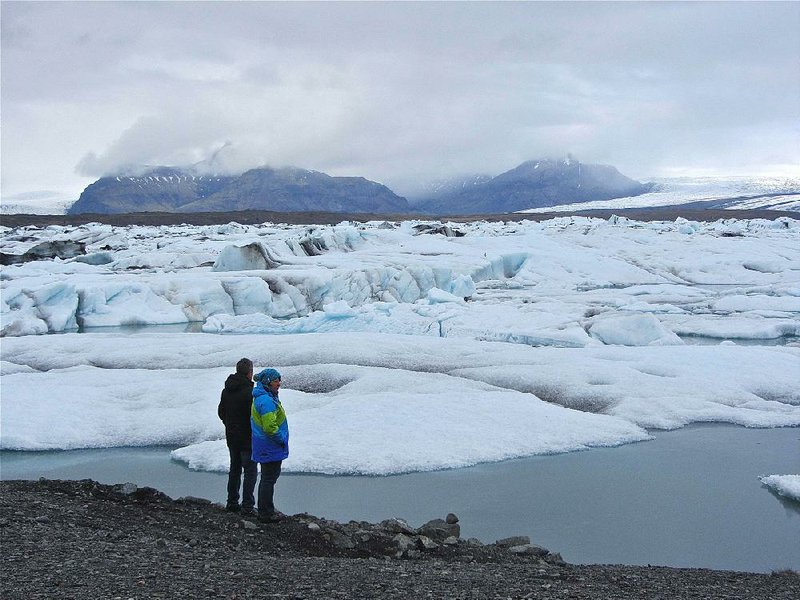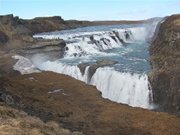REYKJAVIK, Iceland -- Imagine Arkansas dotted with 30 or more active volcanoes. Then you can begin to picture the otherworldly lava landscapes that cover much of Iceland, making this mid-Atlantic island a paradise of photogenic scenery.
Add the good nature of so many Icelanders, the vast majority of whom speak good English. Factor in fascinating history, going back more than millenia to Viking times, as presented with frequent flair in museums and roadside markers. Serve with flavorful dining focused on superbly fresh seafood and lamb, along with vegetables and fruit grown locally in thermal hothouses.
Then you'll understand why wife Marcia and I rank the 24 days in May spent circumnavigating Iceland in a rental car among the most captivating trips in our nearly half-century of traveling.
With about three-fourths the area of Arkansas, Iceland has 30 volcanoes classified as active. The most recent major eruption made global headlines in 2011, when engine-clogging ash from Eyjafjallajokull (a typically jawbreaking Icelandic place name) forced the cancellation of many trans-Atlantic flights for about a week.
Being retired gave us the luxury of meandering. But even a week or so in Iceland is enough to savor this distinctive spot on the planet populated by merely 330,000 souls. That's fewer folks than inhabit metropolitan Little Rock, with two-thirds of Icelanders living in and around the capital, Reykjavik. The rest of the island is blissfully dominated by nature.
Don't expect Iceland to be a bargain destination, but more so the opposite. Restaurant prices are generally higher than in Arkansas, although the difference is eased by the absence of tipping here. We were told that service personnel are paid living wages so that they needn't count on gratuities.
The priciest commodities, compared to back home, include gasoline and alcoholic beverages. Happily, our rented Dacia Duster -- an SUV made in Romania, of all places -- got good mileage. Flavorful local craft beers proved to be the least expensive drinking option.
The photographs adorning this story give glimpses of Iceland's natural grandeur. Entire essays could be written about the lava-sculpted terrain, the hissing fumaroles, the easily accessible glaciers, the thundering waterfalls, all the other astounding scenery. Also a joy is the abundant bird life, as well as the numerous small but sturdy Icelandic horses (one steed for every four Icelanders) and the occasional reindeer herd.
But personal encounters also made our Iceland journey special. Here are some of those moments we treasure from our 3,800 miles on the road:
• At Gandhi, one of several Indian restaurants in surprisingly cosmopolitan Reykjavik, waitress Erda asked about our Iceland itinerary. When I listed Varmahlid among our 11 overnight stops, she said her grandmother ran a small general store near there. We should stop and say "hello" to Granny, she added, writing the address on a scrap of paper. (Alas, I misplaced the note before we reached Varmahlid.)
• At Eldfjallasafn (the Volcano Museum) in Stykkisholmur, the cheerful woman at the admission desk escorted us upstairs to watch a riveting National Geographic video about the 2011 eruption. The museum's collection of volcano-related paintings and sculptures includes a fire-red 1985 Andy Warhol lithograph inspired by Mount Vesuvius in Italy.
• In Reykholt, we felt that we'd practically met Snorri Sturluson, a Viking Age political leader and saga author as familiar to Icelanders as George Washington is to Americans. That was thanks to the half-hour that semi-retired economist Sigrun, project leader at Heimkringla visitor center, spent giving us her authoritative overview of Sturluson. He was hacked to death in his cellar on Sept. 23, 1241. "The bloody tales in our medieval sagas reflect real life of those times," Sigrun said.
• A whale-watching excursion from Husavik on the north coast was enlivened by the banter of guide Nils, who unfurled a buoyant sense of humor. Our fellow passengers were couples from Germany and Romania. Nils seemed as fluently facetious in German as he did in English, and the Romanians also chuckled. Our wildlife sightings included white-beaked dolphins, minke whales and a host of fluttering puffins.
• On the fjord-laced east coast at Stodvarfjordur, we were wowed at Petra Steinasafn museum by the collection of thousands of rocks and mineral specimens amassed by the late Petra Sveinsdottir, who died two years ago at age 89. This devout collector also amassed the hundreds of ballpoint pens on display. The attraction is being maintained by her son and daughter, who did their best in skeletal English to make us feel welcome.
• Iceland's rich 20th-century literary heritage was on display in Skriduklauster at the former estate of Gunnar Gunnarsson, built on the site of a Roman Catholic monastery destroyed after the Protestant Reformation reached the island in the 16th century. Our guide was Darri, an enthusiastic young man who made the past come alive, elaborating on such exhibits as the skull of a syphilis sufferer. The exhibits bypassed Gunnarsson's supposed Nazi German sympathies.
• At the Saga Centre in Hvolsvullur on our final day before returning to Reykjavik, we got more details on the combative life of the Viking era. A surprise here was a gallery in which the weaving of a long tapestry is slowly progressing. We learned from Ingrid, a charming attendant, that this is an attempt to create an Icelandic version of France's famed Bayeux Tapestry. The work is being done by an assortment of locals, ranging in age from 6 to 93.
• Back in Reykjavik at the end of the trip, Harpa concert hall proved to be an architectural dazzler, the more so because our tour guide Elsa is a contralto with a notable European opera career. A highlight came in one of Harpa's three acoustically superlative venues, when Elsa sang a lilting passage from an Icelandic folk song. It was a personal touch, like other encounters in Iceland, that made this journey more than just another sightseeing venture.
Detailed travel information is available at visiticeland.com. Iceland guidebooks worth packing include those from Lonely Planet, Rough Guides and Insight Guides.
Travel on 07/20/2014

